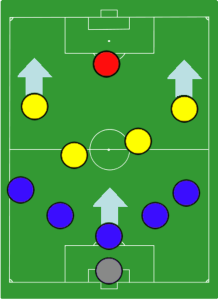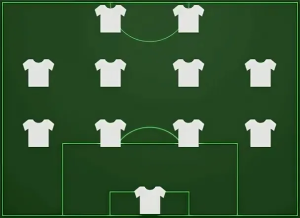Football only seems like a simple game at first glance. In fact, there is a well-thought-out tactic behind the players’ actions on the field. Over the course of the game’s development, the approach to strategies has changed.
In this article, we will tell you everything you need to know about the development of tactics. Understanding this aspect will be especially useful for bettors. You will be able to make more accurate predictions and use 1xBet football bet odds most profitably.
Early Tactics: The Classic Formations
When football appeared at the end of the 19th century, modern tactics did not yet exist.
But, starting in 1870, we can see the first and currently relevant formations of the game in “three lines.” A few decades later, 2-3-5 (which is an inversion of 5-3-2) and “WM” – the most common one – will become popular schemes. WM literally dominated Europe until the 1950s. While teams were trying to find a key to counter it, Gustav Sebes developed an absolutely innovative idea for Budapest Honved and the whole of Hungarian football at that time – positional changes during the game. For example, the central striker began to play in a deep position, which allowed the two attacking midfielders to move higher into his zone and thus create a numerical advantage.
The Hungarians were the first to go beyond the traditional forward role, which contributed to the transition to 4-2-4. The Brazilians adapted this system of play for themselves and modernized it to 4-3-3 in the 1960s. This positional structure became the basis for most teams until the 1970s. In this way, most of the tactics we know today were formed.
At the moment, it is difficult to see the emergence of new schemes. The difference is mostly in micro-tactical details rather than in the general organization of the game.
Defensive Revolution: The Rise of Catenaccio

Since time immemorial, Italy in the world of football has been primarily associated with a style of play aimed at defense. Of all their achievements in this area, Catenaccio – the very popular tactical formation aimed at defense – stands out the most.
The first to put his hand to this formation and essentially create it was the Italian coach Nereo Rocco. At the time of the Swiss team with Karl Rapanna, he was still an ordinary player who, due to the fact that the World Cup was held in Italy, went to the World Cup matches that took place in Turin. It was there, on May 31, that the match between the Swiss and Czechoslovakia teams took place as part of the quarterfinals. Then the Swiss lost 2:3, but Rocco was so drawn to the idea of the “Swiss Castle” that he nurtured the idea of “Catenaccio,” which was built on the basis of that Switzerland, for years.
Catenaccio was used according to the situation. If the Swiss under Karl Rappan always played monotonously and did not deviate from the original tactical plan regardless of the score, then Rocco acted based on the score. He did not change tactics completely in the event of a goal being scored in someone’s goal. No, depending on the score on the scoreboard, he put more emphasis on either defense or attack.
Rocco made “Catenaccio” more variable in attack than the Swiss castle. If the Swiss team had no creativity in attacking variations, and by the way, it was for this reason that they were knocked out by Czechoslovakia, then Rocco began to use abrupt changes in the course of his attacks.
Rocco was the first to use cunning counterattacks. He was, in principle, the first to popularize the tactics of counterattacks, which consist of taking the ball and quickly transferring the initiative to his advantage. He was the first to rebuild the formation during a build-up, the first to rebuild the formation during the transition to full-fledged creation, and the first to use the flank players of the defensive line for these rebuilds rather than the attack and midfield.
Total Football: A Tactical Game-Changer

Rinus Michels was a tough coach who valued discipline. Ajax trained twice a day, whereas previously, there were several training sessions a week. He forced the team to work a lot with the ball to work on teamwork. He was demanding in terms of physical fitness for his team, understanding that without it, their work would be in vain. Michels came to Ajax as a coach in the 1964/1965 season.
The team was close to relegation, but he managed to keep the team in the top division and then changed the team beyond recognition, winning four championships, three national cups, and two gold doubles. Ajax progressed at the European level. In 1969, the club reached the final of the European Champions Cup, and two years later, at Wembley, having beaten Ferenc Puskas’s Panathinaikos, they became the first winner of this trophy.
In 1974, Ajax went to the World Cup with almost its entire squad. Holland reached the final with a goal difference of 14-1, including beating Uruguay, Brazil, and Argentina. The Dutch team demonstrated total football to the world, based on an active change of positions and aggressive high pressing.
Total football is an organized chaos based on the versatility of football players. During an attack, the team creates free space into which partners burst. This often happened with a change of position and was a key difficulty for opponents because most teams defended not in zones, but in people.
A similar principle applies to defense. The first defender was the central striker. The entire team starts pressing and collectively tackling immediately after losing the ball. The main goal is to minimize the space for the ball to move, tackle, and start a new attack.
Johan Cruyff played as a central striker, but his role was much larger. He played as a “false nine,” dropping to the midfielders to play the ball. He played on the left and the right. Johan provided 3-on-2/4-on-3 situations in the final third.
Johan was the starting point for defense, one of the first to press, and he also directed the actions of his partners. His actions are one of the main tools for achieving total football. He changed the size of the playing space by creating an additional numerical advantage, changing positions, and pressing players. Increasing or decreasing space is the key to controlling the opponent.
It is characteristic that Cruyff played this way not only in attack or the first phase of pressing. He often changed positions with the central midfielders and could drop to the position of center-back to maintain the structure.
The 4-4-2 and Other Influential Formations

One of the most traditional formations in football, the classic 4-4-2, has fallen out of favor among top teams around the world.
This system was once widely used in football. It used to have great success in Milan in the 1980s, under the guidance of Italian manager Arrigo Sacchi, who organized pressing of the opponent and placed particular emphasis on the compactness of players and on play on the wings.
From the 80s to the 90s, some of the successful clubs in England at the time also used the 4-4-2 formation. Sir Alex Ferguson’s famous Manchester and Arsene Wenger’s triumphant Arsenal used the 4-4-2 formation to great advantage and brought them great success.
Although it is much less common in recent times, teams such as Juventus and Atletico Madrid continue to use this structure with relative success.
One of the main advantages of the 4-4-2 is the simplicity of the functions/tasks of the player roles compared to other formations. Although the exact requirements always depend on the team’s principles, there is a tendency for such a formation to be easy to implement at various levels of the game.
However, the downside of this advantage can be a lack of dynamism and rapid adaptation to current conditions.
The simple nature of the 4-4-2 also leads to a natural balance within the structure. The symmetrical shape provides a balance of play in defense and attack, allowing the four-man midfield to provide support on both sides.
Another extremely useful advantage is the strength of the formation when the team does not have possession. The 4-4-2 block can be so difficult to penetrate that many teams will defend using this tactic, regardless of what formation they choose to play in attack.
Other formations have also been used:
● The 4-3-3 formation allows for better ball control in the center of the pitch during the attacking phase of the game. At the same time, it can be easily transformed into a 4-4-2 or 4-1-4-1. This formation allows the team to press the opponent high up and encourages the entire width of the pitch to create chances. Pep Guardiola has undoubtedly perfected this system, especially at Barcelona.
● 4-2-3-1 or 4-5-1, which are very similar to 4-3-3, but with the ability to play on the counterattack. Two defensive midfielders, who are positioned directly above the defensive line, play a vital role as they provide team balance and link the defense and attack together.
● 3-4-3 or 3-4-1-2 (in fact, all formations with three central defenders): these tactics are most effective in quick positional transitions of the team from attack to defense (and vice versa) and preventing counterattacks from the opponent. Moreover, they create numerical superiority in attack, which is quite risky, with only three defenders at the back. Wingbacks in such conditions play an important role in maintaining the balance of the game.
Although there are many tactical schemes, only a few teams practice two or three in a game. It is difficult for a coach to instill several schemes in his players and hope that all the players clearly and competently understand the requirements of each individual formation.
Modern Strategies: Pressing and Possession-Based Football
There are many different styles of play in the world of football, each with its own characteristics and philosophy. Some styles have become obsolete and can only be found in the games of teams from the 20th century. One of the most recognizable and aesthetic styles today is Tiki-taka, which originated in Spain and has become a symbol of dominance and technicality.
Tiki-taka is a style primarily based on short and precise passes of the ball, fast movement of players and constant control of the playing space. The term Tiki-taka comes from the sounds that players make when passing the ball to each other.
When studying the strategy, we identified four main principles:
● Constant movement: players using Tiki-taka constantly move around the field, creating reference points for passes and ensuring constant movement of the ball.
● Short passes: the main idea of Tiki-taka is to create playing space through short and precise passes, minimizing the risk of losing the ball.
● High Press: Teams playing the Tiki-Taka style typically apply high press in the opponent’s half of the field in order to quickly win the ball back and create attacks.
● Control of the playing space: The central aspect of Tiki-Taka is the control of the playing space, achieved through constant movement, support of teammates and a high level of technical skill.
Gegenpressing, also known as counter-pressing, is a tactical model of football when the attacking team, while in possession of the ball, loses it in the opponent’s half of the field and immediately after that does not try to take a defensive formation but on the contrary, tries to get the ball back. That is, team A took the ball away due to the usual pressing during defense, and team B, after losing the ball, went on a counter-press and regained possession.
The peculiarity of this method is that the pressing itself is not carried out according to the usual scheme when the opponent already has the ball, and it needs to be taken away. It’s performed in the transition phase of the ball’s movement when it has already been lost by one team but has not yet completely passed to the other. It’s because only after taking the ball away did the pressing team not yet have time to switch from a defensive formation to an attacking one. This moment of disorganization of the opponent allows the team that has lost the ball to quickly go on a counterpressure, not giving the opponent a chance to breathe.
One of the most notable tactical innovations that has changed the face of football in the modern world is the high-pressing, intense pressing tactic. It is actively used by the best teams in the world, changing the dynamics of the game and requiring high physical and tactical preparation from the players.
High-pressing, intense pressing is an active attack on the opponent across the entire field. Instead of waiting for the opponent in their own half, teams use this tactic to attack the opponent immediately after losing the ball. They aim to create high pressure in order to constantly put pressure on the opponent and force them to make mistakes.
Using this strategy brings several advantages to the team’s play. Firstly, it allows the team to control the tempo of the game and dictate its terms. Aggressively attacking the opponent creates trouble and limits their ability to build an attack. Secondly, this strategy helps to quickly regain possession of the ball and gives the team more opportunities to attack.
Conclusion
In modern football, it is difficult to come up with something new. All modern strategies are an improved and reworked version of existing ones. This shows the evolution of football. Nowadays most coaches use a flexible approach to positioning and play. Perhaps there will be new ingenious tactics in the future.

